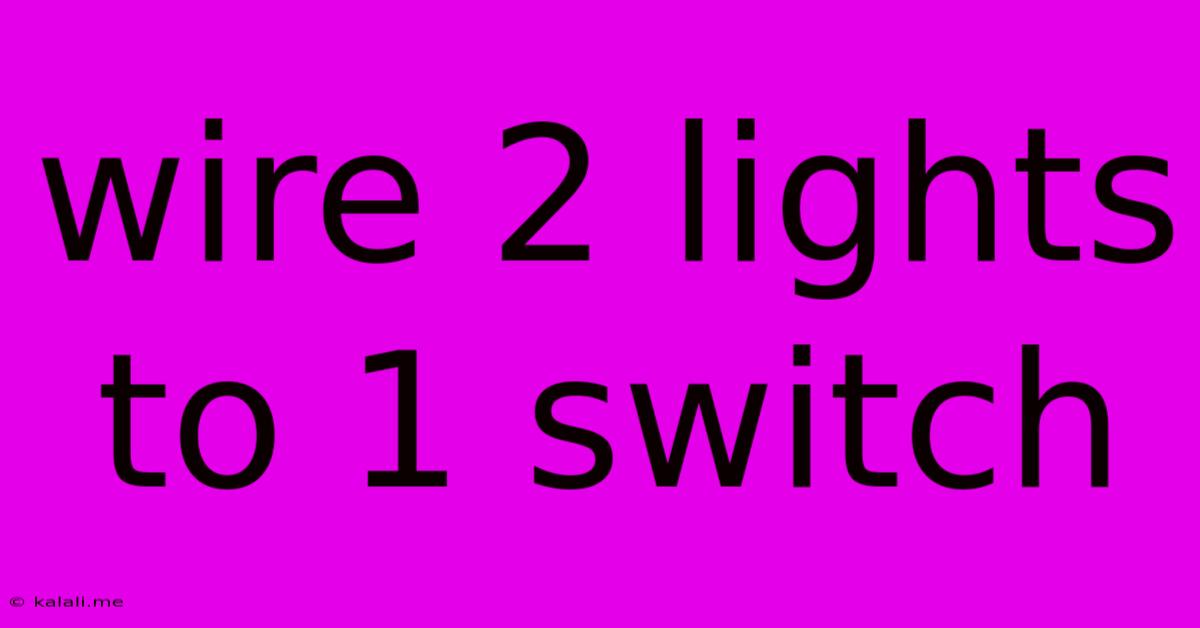Wire 2 Lights To 1 Switch
Kalali
May 20, 2025 · 3 min read

Table of Contents
Wiring Two Lights to One Switch: A Comprehensive Guide
Wiring two lights to a single switch is a common home improvement project that seems daunting but is surprisingly straightforward. This guide provides a step-by-step walkthrough, covering safety precautions and wiring diagrams to help you complete the project successfully and safely. This project requires basic electrical knowledge and comfort with working with household wiring. If you are unsure about any step, consult a qualified electrician.
Safety First: Essential Precautions Before You Begin
Before you even touch a wire, prioritize safety. This project involves working with electricity, which can be dangerous if not handled correctly. Always turn off the power at the breaker box to the circuit you'll be working on. Double-check with a non-contact voltage tester to ensure the power is off. This simple step can prevent serious injury or even death. Additionally, use insulated tools to avoid accidental shocks.
Understanding the Wiring: Parallel Circuits Explained
The key to wiring two lights to one switch is understanding parallel circuits. Unlike a series circuit, where lights would go out if one bulb burned out, a parallel circuit allows each light to operate independently. Each light will have its own hot wire and neutral wire connected directly to the power source. The switches simply control the flow of power to each light.
Materials You'll Need
- Two light fixtures: Ensure they are compatible with your existing wiring.
- One single-pole switch: This is the type of switch that controls the lights from one location.
- Electrical wire: Use wire of sufficient gauge for your lights' wattage. Check the fixture's specifications.
- Wire nuts: These are used to securely connect wires together.
- Electrical tape: For added insulation, although wire nuts provide sufficient insulation when properly installed.
- Voltage tester: To verify the power is off before and after working on the wiring.
- Screwdrivers: Phillips head and flathead, appropriate for your switch and light fixtures.
- Wire strippers/cutters: To neatly strip insulation from the wire ends.
Step-by-Step Wiring Instructions
-
Prepare the Light Fixtures: Carefully remove the existing wiring from each light fixture, noting how the wires are connected. This will help with reassembly. Label the wires (hot, neutral, ground) if necessary.
-
Wire the Lights: Connect the hot wire from each light fixture to a separate wire coming from the switch. Connect the neutral wires from both light fixtures together. Lastly, connect the ground wires from both light fixtures together. Use wire nuts to securely join each set of wires.
-
Wire the Switch: Connect the hot wire from the power source to the switch's common terminal (usually marked with a screw or different color). Connect the hot wires from the lights to the switch's traveler terminal (usually marked as "traveler" or a different color). Connect the neutral wire from the power source directly to the neutral wires of both lights (without going through the switch). Connect the ground wires accordingly.
-
Mount the Switch and Light Fixtures: Securely mount the switch in the electrical box and install the light fixtures.
-
Turn On the Power and Test: After everything is securely connected, carefully turn the power back on at the breaker box. Test both lights to ensure they are working correctly.
Troubleshooting Common Issues
- Lights Don't Turn On: Double-check all connections. Make sure the power is on at the breaker box. Use a voltage tester to verify power at the switch and lights.
- One Light Works, but Not the Other: Check the connections to the problematic light fixture. Ensure proper wire connections and that the bulb is functional.
- Flickering Lights: This might indicate a loose connection, a faulty switch or fixture, or an overloaded circuit.
Remember to consult a professional electrician if you're uncomfortable performing this task. While this guide provides a comprehensive overview, electrical work always carries risks. Prioritize safety throughout the process. Properly completed, however, adding two lights to a single switch is a satisfying and relatively easy project that enhances your home’s lighting.
Latest Posts
Latest Posts
-
Why Is My Led Light Bulb Flickering
May 21, 2025
-
Why Does My Airpods Case Keep Beeping
May 21, 2025
-
Solid White Line On Side Of Road Parking
May 21, 2025
-
What Is A Sill On A Car
May 21, 2025
-
To Do Is To Be To Be Is To Do
May 21, 2025
Related Post
Thank you for visiting our website which covers about Wire 2 Lights To 1 Switch . We hope the information provided has been useful to you. Feel free to contact us if you have any questions or need further assistance. See you next time and don't miss to bookmark.